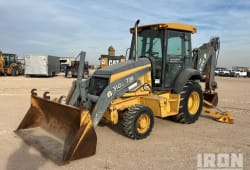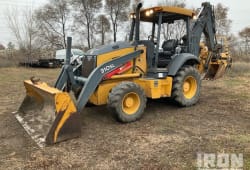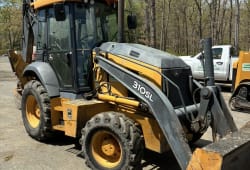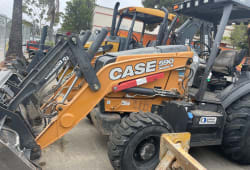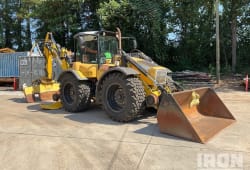How Much Does a Backhoe Weigh?
6 Min read
)
March 3, 2022
The average weight of a backhoe is approximately 15,000 pounds. It is the identical weight of a forklift shipment field. The general weight of a backhoe relies upon the make and model and the attachments that can be used on each machine. Choosing the right size backhoe for you depends on what it'll be used for and how the load will affect your task, group, or business. It may also be helpful for some to learn how to become a backhoe operator.
When do I need to know my backhoe weight?
Knowing the overall weight of the burden on a backhoe is critical in many instances, together with:
Shipping
Lifting it with a crane
Towing
A backhoe's weight can be an essential aspect of your business's performance, so it's vital to understand what can affect a gadget's weight and how it can affect you.
A Brief on Operating Weight
Operating weight is an important specification when thinking about heavy devices like backhoes. It refers to the machine's total weight, including all attachments and fluids. Understanding the working weight is essential for safely transporting, operating, and keeping the backhoe. It ensures the gadget stays within secure operational limits and complies with regulations. Additionally, backhoe weights can vary drastically primarily based on the version, size, and extra attachments, so being aware of the unique operating weight is vital to ensure the system's raised capacity and average overall performance.
Alternatively, lift capability is a vital element that determines a backhoe's capability to hoist and deliver materials. The operating weights of backhoes play a sizeable position in defining their carry ability. The heavier the backhoe, the more extensive the elevated potential it commonly possesses. Hence, expertise in the relationship between running weights and raising capacity is essential for deciding on the proper backhoe for specific duties and ensuring efficient and safe operations on creation sites.
Choose the Right Sized Backhoe loader
Consider a backhoe's length, intensity, and lifting capacity. The device's hydraulic horsepower decides the force and digging depth of the backhoe and loader. Check the specifications carefully to ensure that the device is rated for the intensity and weight of the digging, loading, and moving you'll want it for.
While having a device effective enough to complete the job is crucial, it's also essential to consider the machine's size and operating weight. Many job sites encompass slender spaces, require tight turns, or have delicate grounds or surrounding homes that must be covered throughout the challenge. Understanding the dimensions and weight of a backhoe or trailer is essential to preserving a secure and helpful process website.
Attachments
Backhoe loaders are the most flexible and commonly used equipment on construction and demolition job websites. These creation machines are compact and maneuverable, ready with a boom, stick, and bucket, and can carry out quite a few responsibilities, including digging and shifting materials. Backhoes are most generally used for initiatives in farming, landscaping, construction, demolition, and snow elimination. A backhoe's versatility and performance are enhanced with various attachments that can increase the system's capability. Some of the maximum not unusual backhoe loaders and attachments consist of:
Auger - Adds about 250 lbs
Hammer - Adds about 300 lbs
Thumb - Adds about 150 lbs
Ripper - Adds approximately 350 lbs
Rear Bucket - Adds about 400 lbs
Cold Planer - Adds about six hundred lbs
Coupler - Adds between one hundred - 400 lbs
Backhoes need gasoline to be towed frequently to task websites, so knowing the total weight of your device is crucial. Understanding their general weight and gasoline potential is also essential to protect the operator and the group on the website.
Some Popular Backhoe Models
JCB 1CXT (nine, six hundred lbs)
Caterpillar 434E (18,452 kg)
JCB 3CX (17,196 kg)
New Holland LB90B (18,386 kg)
JCB 4CN (19,510 kg)
:format(webp)) This table affords a top-level view of each popular backhoe model's load and widespread size type.
This table affords a top-level view of each popular backhoe model's load and widespread size type.
Common Uses of Backhoes
Backhoes are small, maneuverable machines with a large loader on their front facet and a boom, stick, and bucket at the backside. Backhoes generally dig as much as 16 feet and may stay stable even on uneven terrain. They are flexible and function as 3 machines: a backhoe, a loader, and a tractor. With their wide variety of attachments, backhoes can deal with several obligations, from demolitions, creation, landscaping, avenue paving, excavating, and transporting materials.
In its middle, a backhoe loader is a tractor that can maneuver through bumpy or tough terrain. Its effective engine helps it easily dig up or transport heavy gravel, rock, and soil while also easily maneuvering uneven floors.
The loader is on one quit of the system, which enables it to scoop up and bring loose fabric, smooth out a surface, or plow dirt. On the opposite side is the backhoe, which is used to dig up material. This is difficult to reduce by loading, including compact earth, into its bucket and emptying it off to the side to hold digging. Backhoes are fantastic for tasks including:
Digging up bushes
Moving dirt and different unfastened substances
Packing topsoil
Digging fence publishes holes
Digging swimming pools
Digging trenches
Moving heavy items such as rocks, boulders, and hay bales
Paving roads
Foundation paintings
With their versatility, backhoes are an asset on any job site. They are commonly known as the "Swiss army knife" model of heavy machinery and are suitable for jobs of all sizes. As with any piece of equipment, it is critical to comprehend the specifications and features of your device to ensure that it is used correctly to keep the crew, operator, and process web page secure.
Comprehensive Overview of Backhoe Weight and Usage
:format(webp))
In the end, knowledge of the load of a backhoe is paramount for diverse operational aspects, which include shipping, lifting, towing, and average undertaking performance. With an average weight of around 15,000 kilos, comparable to a forklift shipment container, the entire weight can affect mission outcomes and resource allocation extensively. It's critical to consider factors such as make, version, and attachments to examine the backhoe's weight correctly. By prioritizing know-how of the total weight, organizations can ensure secure and green utilization of backhoe gadgets, which, in the long run, is central to more advantageous task performance and fulfillment.

